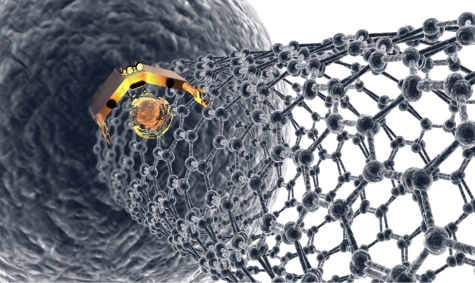Nanobots: Our Tiny Saviors
The future of robotics…goes inside you?
Nanobots are exactly what they sound like. They are tiny, miniscule robots capable of storing and applying medicinal content to the human body, among other things. Currently, the average nanobot is about 0.1-10 micrometers. To put that into perspective, the average sand grain is about 62.5 micrometers. Yeah, I know, amazing! Yet, scientists are striving to make them even smaller.
As previously stated, nanobots can have an enormous impact on the medical industry. Normally, to fight a disease or to insert a vaccine, a doctor would inject a drug into one’s body. However, the flaw with this is that the drug has to go through the patients entire body until it reaches the desired part. With nanobots, however, a drug can be delivered to the infected or disease-ridden part fast, efficiently and reliably. Yet, this is not the only applicable use for nanobots in the medical industry. Scientist have discovered that nanobots can be used to repair damaged cells and genetic discrepancies, which is something that has never been able to be done. Additionally, the nanobot can become cells themselves, combating blood cancers like leukemia, lymphoma, and myeloma, potentially saving thousands of lives. However, nanobots aren’t only applicable in the medical field.

Nanobots are especially useful in construction. For anyone who has seen Avengers: Infinity War or Avengers Endgame, they know that Tony Stark’s M85 suit shows us a glimpse of what nanotech may look like in the future. Today however, nanobots can be used to test a structure’s integrity and get accurate data about it, testing and scanning places that are unknown or unreachable. Additionally, they can be useful for builders, such as temporarily forming a wall or sealing a broken pipe. Not only will this save time and lives, it can also save money. Certain nanobots are polymorphic, meaning that they can change in shape or form. This would be a very effective rebuilding method. For example, if a person doesn’t like the way their house is built, they can use nanobots to change the structure of their home. Essentially this means that the average home owner can rebuild their entire house structure, without having to tear it down.
Finally, nanotechnology can be a proficient ally in space exploration. On average, NASA spends $10,000 per pound sent into space. That means that NASA spends over a million dollars just to put one human into space. However, this is not the case with nanotech. With nanotech, spacecraft can be made stronger and lighter, and cheaper. One such example of this material is Carbon nanotube. Carbon nanotube consists of carbon molecules rolled into a cylindrical shape. They are stronger than steel and conduct electricity better than other metals. Additionally, carbon nanotubes can be used in solar panels and solar sails to absorb energy from light photons more effectively and put the power towards the propulsion of the spacecraft.
While today, we have made substantial progress with nanobots and nanotech, we still have a long way to go before it becomes anywhere close to perfect. Nanotech is a promising field of STEM that is advancing everyday, and will benefit millions in the future.















